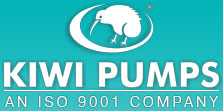
Pumps Information » Explosion Proof Pumps
Explosion Proof Pumps
Explosion Proof Pumps prevent internal or external explosions by enclosing parts that could ignite either the transfer media or the surrounding atmosphere. Some explosion-proof pumps are designed to move abrasive materials, acids, adhesives, chemicals, concrete and grout, coolants, hazardous materials, liquid metal, or lubricants. Other devices are rated for combustible, corrosive, high viscosity, or high temperature media. Explosion-proof pumps are also used to move gasoline, diesel fuel, and oil; ground water, potable water, salt water, and wastewater; sewage, sludge, slurry and ash slurry; gas and air; powders, solids, and rendering wastes; and a variety of liquids and liquids with solids.
Many types of explosion-proof pumps are available. Bladder pumps are low-flow pneumatic devices used in sampling applications. Canned motor pumps feature an enclosed electric motor and an inner rotor that is directly connected to the pump impeller. Centrifugal pumps apply centrifugal force to generate velocity, use rotating impellers to increase velocity, and push fluids through an outlet valve. Diaphragm pumps include suction and discharge check valves to prevent backflow. Piston and plunger pumps use a plunger or piston to move media through a cylindrical chamber.
Peristaltic pumps are rotary devices that move media through a tube that is compressed at a number of points through contact with rollers or shoes. Gear pumps transport high pressure and high volume flows through positive displacement. Drum pumps are designed to transport or dispense the contents of drums, pails, or tanks. Grinder pumps shred solids, macerator pumps empty holding tanks of sewage, and sampling pumps extract small amounts of media for analysis. Other types of explosion-proof pumps include axial pumps, condensate pumps, dosing pumps, fire service pumps, jet pumps, mixing pumps, screw pumps, sump pumps, refueling pumps, and rotary lobe pumps. Important specifications for explosion-proof pumps include maximum discharge flow, maximum discharge pressure, inlet size, discharge size, and media temperature. Power sources include alternating current (AC), direct current (DC), compressed air, gasoline, diesel fuel, hydraulic systems, natural gas, steam, water, and solar energy. Pumps that do not include a power source typically provide a drive shaft for connection to a motor.
Manually powered pumps rely upon hand or foot power.Explosion-proof pumps are used in a variety of commercial, industrial, municipal, and maritime applications. Examples include agriculture and horticulture, dairy farms, breweries and distilleries, construction, flood control, food service and food processing, power generation, and oil and gas production. Explosion-proof pumps are also used in the aerospace and defense, automotive, machine tool, mining, medical, pharmaceutical, semiconductor, and paper industries. Devices for heating, ventilation and air conditioning (HVAC) systems are also available. Cryogenic pumps are rated for conditions where temperatures are low enough for gases to condense to become liquids or solids. Petrochemical and hydrocarbon pumps are rated for materials such as gasoline, kerosene, diesel oil, lubricating oil, paraffin wax, and asphalt.
